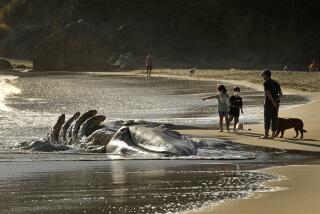Scientists solve mystery of mass whale graveyard in Chile
Scientists have uncloaked the mystery of an ancient fossilized graveyard of dozens of whales lying side by side with bizarre, walrus-faced dolphins and swimming sloths.
The fossils, unearthed about three years ago during a road-widening project in Chile’s Atacama Desert, probably record a series of mass strandings about 6 million to 9 million years ago that were caused by blooms of algae fed by the iron-rich sediments of the Andes Mountains, according to a study published online Wednesday in the journal Proceedings of the Royal Society B.
The international team of researchers believes about four waves of carcasses washed into what once was a placid tidal basin within a period of weeks, then were buried in sediments that accumulated over 10,000 to 16,000 years, said the study’s lead author, Nicholas D. Pyenson, curator of fossil marine mammals at the Smithsonian Institution.
How the fossils came to rest 130 feet above sea level is less a mystery than it may seem: The Nazca, Antarctic and South American plates have been grinding against each other for millions of years, pushing up the Andes Mountains.
The whale skeletons, all from the rorqual super-family that includes modern blue whales, were largely intact, with few signs of scavenging other than the marks of crab claws, Pyenson said.
“South America did not have polar bears or any large terrestrial carnivores that would scavenge and disarticulate the skeletons,” he said. “Crabs must have had a field day out there.”
One set of fossils, dubbed “la familia,” or “the family,” included two adults and a calf.
While the so-called whale graveyard has attracted the most attention since the find during road widening from 2010 to 2012, the smaller species at the site are also of keen interest to paleontologists.
“We have ancient seals; we have ancient bill fishes -- there are swordfish and marlin remnants,” Pyenson said. “And then there are the totally extinct exotic things: aquatic sloths and walrus whales.”
The swimming sloth and walrus whale remains are found only in South America, and no walrus whale had ever been found outside neighboring Peru.
“It’s amazing to me. In 240 meters of road cut you collect all the major players for the fossil marine mammal world in South America,” Pyenson said.
It took about three years to piece together the evidence to offer the most plausible explanation for the density of fossils.
The steady accumulation of sediment, undisturbed by major waves, suggested a tidal environment, according to the study. All the animals were belly up, suggesting they were dead when they floated in. The lack of any trauma marks on their bones, the varied ages of the dead and the array of species led researchers to suspect some broadly potent toxin killed them.
Nearby, orange-colored blotches contained tiny spherical fossils of the same size as dinoflagellate cysts -- algae. Iron oxide was abundant in the sediments as well -- and iron is an important driver of algal blooms. The Humboldt current was probably in place -- all of the major continents were roughly in modern form at the time.
The most likely explanation that encompasses all of that evidence would be an upwelling of ocean water, fed by iron-rich runoff from the nascent Andes, which fed massive algal blooms that poisoned the mammals by direct ingestion or inhalation or through the prey they ate, the study suggested.
Researchers noted a modern stranding of 14 humpback whales that occurred in a five-week period off Cape Cod in 1987 and 1988. Necropsies revealed high concentrations of neurotoxins in the tissue of the mackerel found in their digestive tracts.
“This is largely an ecological story in the past,” Pyenson said. “It’s a naturally occurring thing, and the conditions were right. Clearly the conditions were right four times.”
Researchers created a three-dimensional digital record of the fossils, which were removed and held at two sites in nearby Caldera and the capital, Santiago.
“Nothing ever left Chile. That’s something that we’re proud of,” Pyenson said. “There’s a digital legacy online. But the patrimony was preserved.”
The excavation site has since been paved to allow more trucks to access nearby copper mines, which are booming amid high demand from China.







